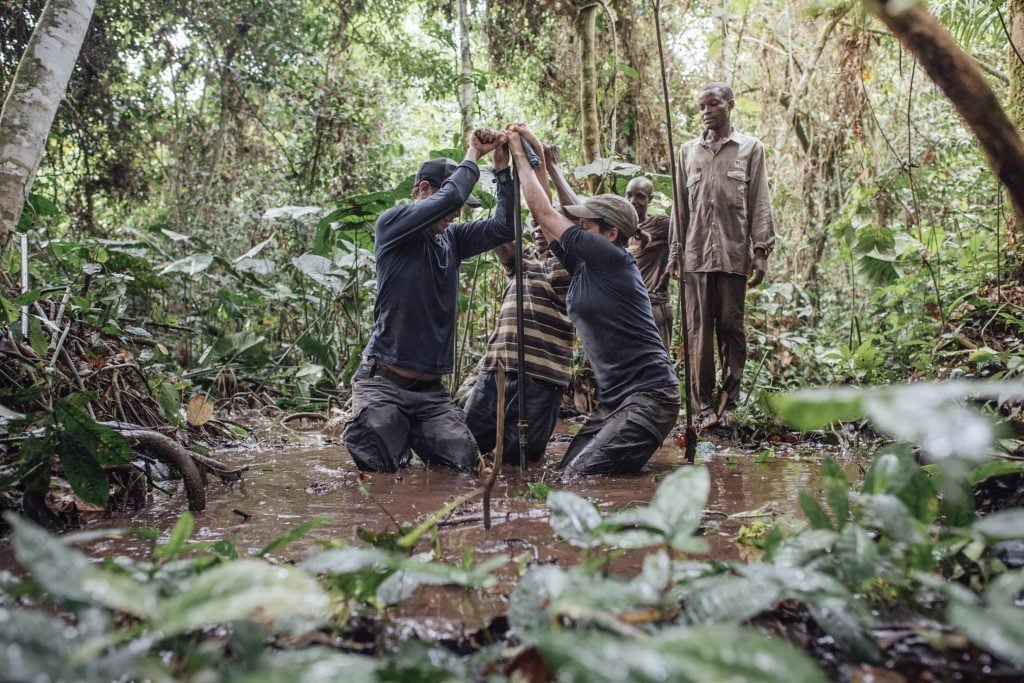With a 145,500-square-kilometer swath of peatlands in Central Africa newly identified as an important storage of carbon, researchers, decision-makers and practitioners are now discussing the likelihood of and means for keeping this water-logged area intact.
“There’s a lot of carbon in those peatlands,” says Dr. Greta Dargie, a forest ecologist who co-authored recent articles with a team of scientists and served on the technical advisory group of the upcoming Global Landscapes Forum Digital Summit spotlighting the issue.
Located in the heart of the Congo Basin, the peat – boggy, soil-like matter composed of decayed vegetation – of the little-known Cuvette Centrale peatlands stores an estimated 30.6 petagrams of carbon (roughly equivalent to 20 years of the U.S. carbon emissions) in an area slightly larger than England. Combining field work with satellite data sets, Dargie and her team learned that these peatlands contain one-third of the world’s currently known tropical peat and are much larger than previously thought.
Yet, a number of threats could cause this carbon to release into the atmosphere, adding to the threats of climatic changes. Research in recent years has found that greenhouse gases emitted from a small area of peatlands amount to 5 percent of global human-induced emissions.
“Being seemingly largely dependent on rainfall, the Cuvette Centrale peatlands are particularly vulnerable to climate change,” says Dargie. She expressed pointed concern about a reduction in rainfall or a change in its distribution, which could lead to the peatlands drying, increased peat decomposition and subsequently the release of carbon. Dried-out peatlands burn easily, not only destroying ecosystems but also potentially leading to intense regional smoke and haze, as occurred in the deathly 2015 fires in Indonesia.
Other potential threats to the peatlands’ hydrology include drainage-based farming and logging, mining, oil extraction and infrastructure building. Combined with potential future scenarios of better roads and river access as well as hotter, drier conditions resulting from global warming (which Dargie’s article refers to as ‘synergies of degradation’), these impacts from human activity could lead to deforestation, contamination of soil and water, and overall landscape degradation, especially given the lack of effective conservation and land management.
Currently, only about 11 percent of Cuvette Centrale falls under official national protected areas. Other conservation initiatives, such as inclusion in Ramsar’s Wetlands of International Importance, cover more of the area but do not legally require protective action.
During field measurements taken between 2012 and 2014, Dargie and her team collected data on peat depth (two meters, on average) and samples to determine the carbon density both in the peat and in overlying trees. They also found two types of distinctive swamps – one dominated by hardwood and the other by palm – that allowed them to map the peatlands using satellite data.
In addition to peat, the area’s swampy forests are vital to regional hydrology in ways still being studied; the livelihoods of local communities, which depend on peatlands for diets and incomes through means such as fishing and agriculture; and the conservation of rare biodiversity, including vulnerable and threatened species like lowland gorillas and forest elephants.
To better protect the rest of the Congo Basin’s peatlands, Dargie stresses the need for improved understanding of how the Cuvette Centrale ecosystems function, in order to better inform land use planning and management as well as related policy- and lawmaking. There is an evident need to raise awareness among governments, civil society and the private sector on the importance and preservation of peatland ecosystems at large, as well as convene a wide range of stakeholders around these landscapes.
Zooming out, these peatlands are connected to international efforts to reduce greenhouse gas emissions and to limit the degree of climate change. They could serve as an entry point for efforts to mobilize funds for climate mitigation, adaptation and disaster risk reduction.
“Climate change emerges as a particularly pressing concern, given its potential to destabilize carbon stocks across the whole area,” says Dargie. “But the low level of human intervention at present suggests that the opportunity still exists to protect the peatland landscapes and people living in them.”
Click here to read the original article.


Je suis intéressé par cette article ,j’aimerais approfondie les études sur dysfonctionnement des écosystèmes de la cuvettes centrale